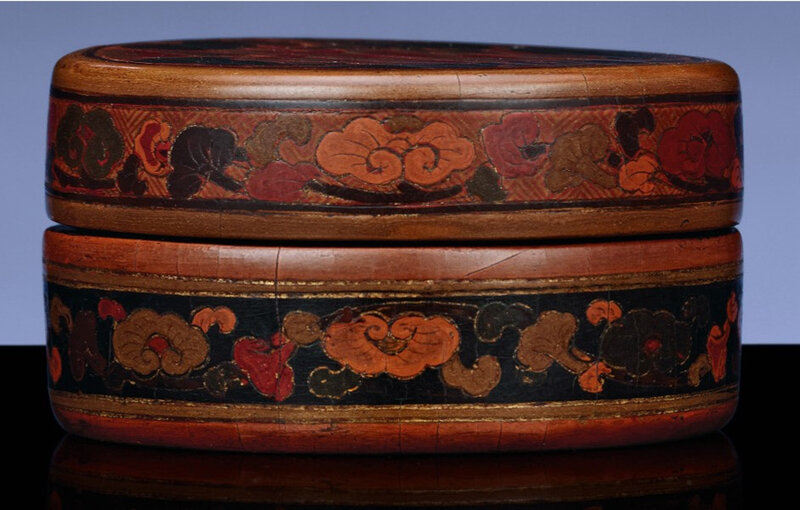Delicately incised and gilt to the cover with a single central gardenia bloom flanked by two further buds and furled leaves, all picked out in red, brown, green and black and reserved on a diaper ground of wan characters, the sides of the box and cover with band of lingzhi borne on an undulating scroll on either red wan emblems or black grounds, the base incised on the right side with the reign mark, Japanese box.
Provenance: The Nagata Collection, Tokyo, Japan.
Literature: Tea Ceremony Items, vol. 10, Incense boxes, Japan, 2000 p. 58-59.
Note: Published examples of tianqi lacquer dating to the early 15th century are extremely rare. A large tianqi lacquer chest attributed to the first half of the 15th century formerly in the Fritz Low-Beer Collection and now in the Victoria and Albert Museum is illustrated in Im Zeichen Des Drachen, Munchen, 2006, no. 102 and is probably the most famous example in this group. A number of comparable boxes and covers have also been published including a Xuande-marked oval 'peony' box and cover in the Palace Museum collection, Beijing, illustrated in Lacquer Wares of the Yuan and Ming Dynasties, The Complete Treasures of the Palace Museum, vol. 35, Hong Kong, 2006, pp. 88-89, no. 62 which displays a very similar decorative motif to the current box and cover; and a Xuande-marked circular tianqi 'three friends' box in the Tokyo National Museum exhibited in the 1977 Special Exhibition, Oriental Lacquer Arts and illustrated in the catalogue, no. 516.
Christie's. The Imperial Sale Important Chinese Ceramics and Works of Art, Hong Kong, 31 May 2010

/https%3A%2F%2Fprofilepics.canalblog.com%2Fprofilepics%2F1%2F0%2F100183.jpg)
/https%3A%2F%2Fstorage.canalblog.com%2F03%2F02%2F119589%2F96711876_o.jpg)
/https%3A%2F%2Fstorage.canalblog.com%2F11%2F31%2F119589%2F94773502_o.jpg)
/https%3A%2F%2Fstorage.canalblog.com%2F20%2F83%2F119589%2F94772815_o.jpg)
/https%3A%2F%2Fstorage.canalblog.com%2F26%2F72%2F119589%2F75604929_o.jpg)
/https%3A%2F%2Fstorage.canalblog.com%2F59%2F60%2F119589%2F26458628_o.jpg)




/http%3A%2F%2Fstorage.canalblog.com%2F17%2F73%2F119589%2F128475860_o.jpg)
/http%3A%2F%2Fstorage.canalblog.com%2F19%2F06%2F119589%2F127776680_o.jpg)
/http%3A%2F%2Fstorage.canalblog.com%2F70%2F40%2F119589%2F126469805_o.jpg)
/http%3A%2F%2Fstorage.canalblog.com%2F12%2F80%2F119589%2F122439633_o.jpg)